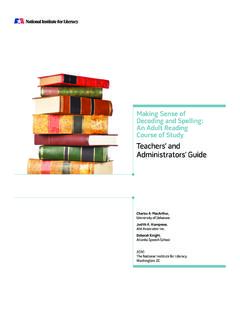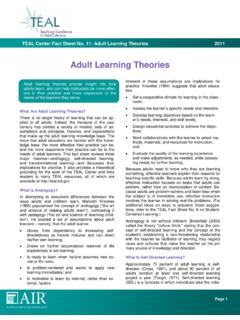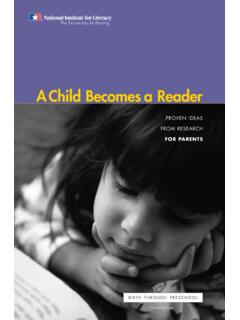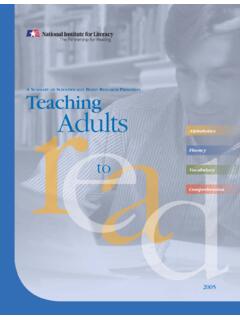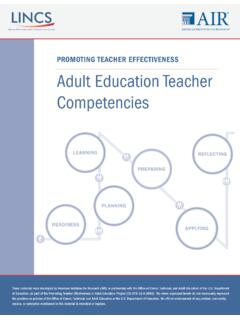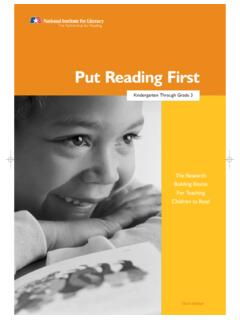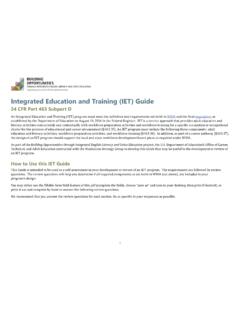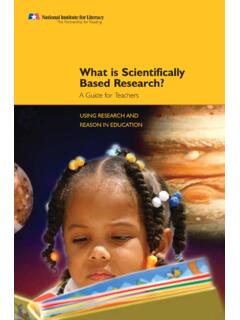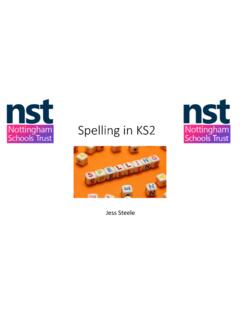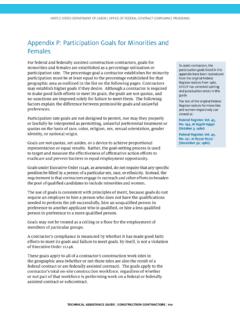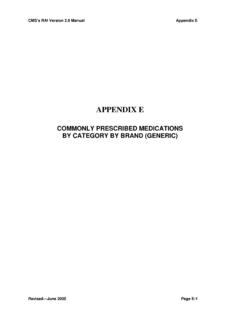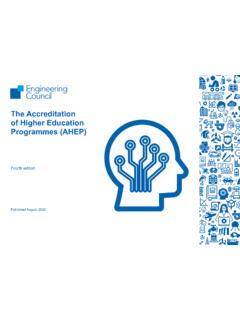Transcription of Making Sense of Decoding and Spelling: An Adult Reading ...
1 Charles A. MacArthur, University of DelawareJudith A. Alamprese, Abt Associates Knight, Atlanta Speech SchoolAugust 2010 The National Institute for LiteracyWashington, DCMaking Sense of Decoding and spelling : An Adult Reading Course of StudyLesson PlansThe Teachers Guide, Lesson Plans, and Learner Activity Book that comprise the Making Sense of Decoding and spelling : An Adult Reading Course of Study were prepared for dissemination under National Institute for Literacy Contract No. ED-NIL-09-C-0058 with the University of Delaware. The development and evaluation of this course of study was supported by a grant to the University of Delaware and Abt Associates Inc. jointly funded by the Eunice Kennedy Shriver National Institute of Child Health and Human Development (NICHD) (5R01HD43798), the National Institute for Literacy (NIFL), and the Office of Vocational and Adult Education (OVAE) of the Department of Education.
2 The Reading course of study materials were written by Charles A. MacArthur, University of Delaware; Judith A. Alamprese, Abt Associates Inc.; and Deborah Knight, Atlanta Speech School. Lynn Reddy served as the contracting officer s representative. Patricia Bennett served as the Program Officer. The views expressed herein do not necessarily represent the positions or policies of the National Institute for Literacy. No official endorsement by the National Institute for Literacy of any product, commodity, or enterprise in this publication is intended or should be National Institute for Literacy, a Federal government agency, is a catalyst for advancing a comprehensive literacy agenda. The Institute bridges policy, research and practice to prompt action and deepen public understanding of literacy as a national Miller, Acting DirectorLynn Reddy, Deputy DirectorAugust 2010 The citation for this document should be: MacArthur, , Alamprese, , & Knight, D.
3 (2010), Making Sense of Decoding and spelling : An Adult Reading Course of Study, Lesson Plans. Washington, DC: The National Institute for document may be downloaded at Lesson Plans i Preface Making Sense of Decoding and spelling : An Adult Reading Course of Study is an evidence-based course of study designed to teach Adult learners to decode and spell words more accurately and fluently. It is designed to be used as one component of a comprehensive Adult Reading course. The target population for the course is ABE learners at the low-intermediate level (4th-7th grade equivalence level). It contains 30 scripted lesson plans. The course begins with a review of basic alphabetic Decoding skills and then teaches the most common and useful patterns of English words, and their applications in Decoding , spelling , and fluent Reading .
4 The course was evaluated in an experimental study. NOTE: It is important that instructors have all materials to use this Reading course of study effectively. These Lesson Plans are designed to be used in conjunction with the other materials that make up the course. Materials for the course include three documents and a set of charts: Teachers Guide Lesson Plans (This document) Learner Activity Book Charts (in the appendix of the Lesson Plans and Learner Activity Book) The Teachers and Administrators Guide presents information about the core concepts, design, research base, and implementation of the Making Sense Reading course of study. It contains guidance for ABE instructors about the knowledge that is needed to teach Making Sense , the structure and content of the lessons in the course, and the integration of Making Sense within a comprehensive Adult Reading course.
5 This Lesson Plans document includes the 30 scripted lessons with related materials which can be made into overhead transparencies or PowerPoint slides. The Learner Activity Book is designed for use by individual learners in conjunction with the lessons; each learner should have a copy. The Charts are designed to hang on the wall; copies are in the Teachers Guide and Learner Activity Book. All materials are designed to be downloaded from the Internet, printed, and copied for use at no cost. Authors Charles A. MacArthur is a professor in the School of Education at the University of Delaware. His major research interests include Adult literacy, writing development and instruction for struggling writers, and strategy instruction.
6 He was the principal investigator of the project that developed and evaluated the Making Sense course of study. Lesson Plans ii Judith A. Alamprese is a Principal Associate at Abt Associates Inc. Her research and evaluation interests include Adult Reading instruction, Adult education program quality, interagency coordination, Adult basic education and career pathways, and state systemic change. She was the director of the experimental study in which the Making Sense course of study was evaluated. Deborah Knight is Co-Director of the Rollins Center for Language & Learning at the Atlanta Speech School where she leads a team of coaches who provide comprehensive professional development in literacy for schools.
7 She was an investigator on the project that developed the Making Sense course of study. Acknowledgements Many individuals contributed to the development and evaluation of this course of study. We would like to thank our project officers, Peggy McCardle and Brett Miller from NICHD, Ricardo Hernandez from OVAE, and Sandra Baxter, Lynn Reddy, and Patricia Bennett from NIFL for their support throughout the project. They were active participants in coordinating our efforts with our group of research projects. The funding from NIFL to disseminate the results of our work is much appreciated. We also would like to thank the many staff that made the project possible through their hard work and dedication: Abt Associates Price and Amanda Parsad for the statistical analyses, Fumiyo Tao for site recruitment, management, and data collection, Kathie Mackin and Nancy Brigham for data collection, Daphne Garcia and Meredith Beck for data coding and processing, and University of Delaware research assistants Allison Golinkoff, Leah Lembo, Katya Midgette, Zoi Philippakos, and Ximena Uribe.
8 Finally, we would like to thank the many Adult education instructors and learners who contributed their time and knowledge in providing feedback on the Making Sense instruction. This feedback was essential to the improvement and success of the course. There are too many to name, but we deeply appreciate their contributions without which this work would not have been possible. Lesson Plans iii Table of Contents Scope and Sequence of Lessons 1 Notes on Using the Lesson Plans Using the Teachers Guide, Lesson Plans, and Learner Activity Book 4 Formatting Conventions for the Lesson Plans 5 Lesson Plans (with Materials) Lesson 1: Overview / Introduction 1-1 Lesson 2: Short a and e in CVC Syllables 2-1 Lesson 3: Short i, o, and u in CVC Syllables 3-1 Lesson 4: Syllable Division with CVC Syllables 4-1 Lesson 5: Prefixes and Suffixes that are CVC Syllables 5-1 Lesson 6: Review 6-1 Lesson 7: Long Vowels in VCe Words 7-1 Lesson 8: Dropping the Final e Prior to a Suffix 8-1 Lesson 9.
9 Doubling the Final Consonant in CVC Syllables 9-1 Lesson 10: Variations on the Final-e Pattern 10-1 Lesson 11: Review 11-1 Lesson 12: The Cle Pattern 12-1 Lesson 13: Open Syllables 13-1 Lesson 14: Stress and Schwa 14-1 Lesson 15: Review 15-1 Lesson 16: Sounds of y; Words Ending in y and ey 16-1 Lesson 17: Changing y to i When Adding a Suffix 17-1 Lesson 18: Prefixes and Suffixes 18-1 Lesson 19: Review 19-1 Lesson 20: Digraph Vowels (ai, ay, ee, ey) 20-1 Lesson 21: Digraph Vowels (oa, ou, ow) 21-1 Lesson 22: Digraph Vowels (oi, oy, oo) 22-1 Lesson Plans iv Lesson 23: Digraph Vowels (ea) 23-1 Lesson 24: Syllables with r-Colored Vowels 24-1 Lesson 25: r-Colored Vowels.
10 Suffixes or and -ard 25-1 Lesson 26: Review 26-1 Lesson 27: Soft and Hard Sounds of c 27-1 Lesson 28: Soft and Hard Sounds of g 28-1 Lesson 29: Review 29-1 Lesson 30: Grand Finale 30-1 appendix : Charts Six Syllable Patterns Chart A-1 spelling Rules Chart A- 2 Strategy for Reading Multisyllabic Words Chart A- 3 Prefixes Chart A- 4 Suffixes Chart A- 5 Prefixes and Suffixes Bookmark A- 6 Syllables and Strategy Credit Card A- 7 Vowel Pronunciation Guide A-8 Lesson Plans 1 Scope and Sequence of Lessons Lesson 1: Introduction The first lesson introduces the course as the study of how the English language works and teaches the basic concepts of phonemes and syllables with a few exercises.
